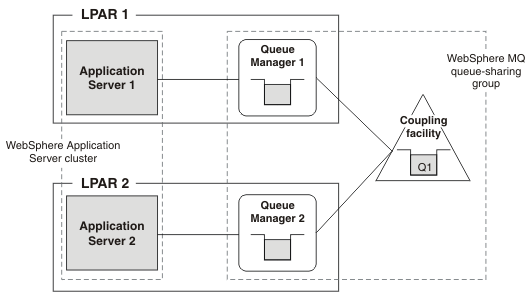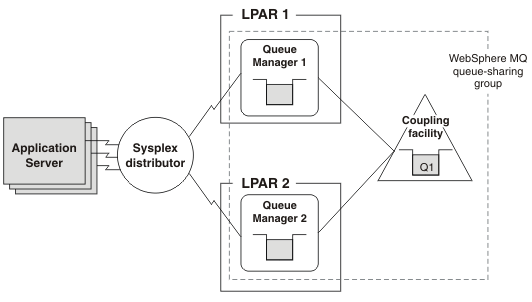Connect WebSphere Application Server application servers to WebSphere MQ for z/OS with queue-sharing groups
On z/OS systems, an application server can connect to a queue manager that is a member of a WebSphere MQ for z/OS queue-sharing group. We can configure the connection so that it selects a specific named queue manager, or we can configure it to accept any queue manager in the queue-sharing group.
In this topic "application server" refers to an application server running on WebSphere Application Server and "queue manager" refers to a queue manager running on WebSphere MQ.
If we configure a connection to select a specific named queue manager, the options for providing high availability are like those for connecting to WebSphere MQ on other platforms. However, we can improve availability if you configure the connection to accept any queue manager in the queue-sharing group. In this situation, when the application server reconnects following a WebSphere MQ queue manager failure, the application server can accept connection to a different queue manager that has not failed.
A connection configured to accept any queue manager must only be used to access shared queues. A shared queue is a single queue that all queue managers in the queue-sharing group can access. It does not matter which queue manager an application uses to access a shared queue. Even if the same application instance uses different queue managers to access the same shared queue, this always produces consistent results.
These examples show two topology options for connecting to WebSphere MQ for z/OS to benefit from queue-sharing groups:
- The application servers and the queue managers run in the same logical partition (LPAR)
- The application servers and the queue managers run in different logical partitions (LPARs)
The application servers and the queue managers run in the same logical partition (LPAR)
The following figure shows a bindings mode connection from WebSphere Application Server to WebSphere MQ for z/OS. The figure shows the following configuration:
- Application servers 1 and 2 are part of a WAS cluster.
- Application server 1 is running in LPAR 1.
- Application sever 2 is running in LPAR 2.
- Queue managers 1 and 2 are members of a WebSphere MQ queue-sharing group that hosts a shared queue, Q1. The shared queue is located in a coupling
facility.
- Queue manager 1 is running in LPAR 1.
- Queue manager 2 is running in LPAR 2.
- A "bindings" connection is used when the application server and the queue manager are running on the same host. This is a cross-memory connection that is established to a queue manager running on the same host. A bindings connection is also known as "call attach".
- Application server 1 and queue manager 1 are attached to each other in bindings mode.
- Application server 2 and queue manager 2 are attached to each other in bindings mode.
- Application server 1 and queue manager 1 are attached to each other in bindings mode.
Figure 1. WebSphere Application Server with bindings mode connection to WebSphere MQ for z/OS

This networking topology can benefit from "pull" workload balancing if several application instances, including instances running in different LPARs, are processing messages from the same shared queue.
We can improve availability for this topology using the z/OS Automatic Restart Manager (ARM) to restart failed application servers or queue managers. If a queue manager in an LPAR fails, ARM can restart an application server in a different LPAR, where the application server can connect to a running queue manager, instead of waiting for a restart of the queue manager that it was using previously. In the example used here, ARM can restart WebSphere Application Server application server 1 in LPAR 2, where it can connect to WebSphere MQ queue manager 2, instead of waiting for queue manager 1 to restart.
The application servers and the queue managers run in different logical partitions (LPARs)
The following figure shows a client mode connection from WebSphere Application Server to WebSphere MQ for z/OS. The figure shows the following configuration:
- Queue managers 1 and 2 are members of a WebSphere MQ queue-sharing group that hosts a shared queue, Q1. The shared queue is located in a coupling
facility. The two queue managers run in different LPARs.
- A "client" connection is used when the application server and queue manager are running on different hosts. This is a TCP/IP network connection used to communicate with the queue
manager. A client connection is also known as "socket attach".
- Multiple application servers have a client mode (TCP/IP) connection to the queue managers. All the client mode connections are managed by the z/OS sysplex distributor, which selects either queue manager 1 or queue manager 2 for each connection request.
Figure 2. WebSphere Application Server with client mode connection to WebSphere MQ for z/OS

As with the bindings mode connection example, this networking topology can benefit from "pull" workload balancing if several application instances running in the same or different application servers are processing messages from the same shared queue.
The use of the z/OS sysplex distributor improves availability for this networking topology. If one of the queue managers fails, the z/OS sysplex distributor can connect applications running in the application servers to the other queue manager, without waiting for the failed queue manager to restart. In the example used here, if queue manager 1 fails, the z/OS sysplex distributor can select queue manager 2 for every connection request, until queue manager 1 restarts.
In this networking topology, WebSphere MQ for z/OS GROUP units of recovery must be enabled on all the queue managers in the queue-sharing group. TCP/IP (client mode) connections that accept any queue manager use GROUP units of recovery. GROUP units of recovery are not supported by versions of WebSphere MQ for z/OS earlier than Version 7.0.1. Bindings mode connections do not require GROUP units of recovery.